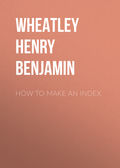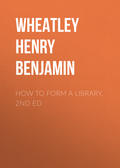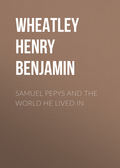
Wheatley Henry Benjamin
How to Catalogue a Library
CHAPTER VI.
ARRANGEMENT
Rule II. of the British Museum is: "Titles to be arranged alphabetically, according to the English alphabet only (whatever be the order of the alphabet in which a foreign name might have been entered in its original language);" and this rule has been generally followed. Mr. Cutter (rule 169) adds to this, "Treat I and J, U and V, as separate letters;" and every consulter of the British Museum Catalogue must wish that this rule was adopted there, for anything so confusing as this unnecessary mixing of the letters I and J and U and V it is scarcely possible to imagine. Mr. Cutter goes on: "ij, at least in the olden Dutch names, should be arranged as y; do not put Spanish names beginning with Ch, Ll, Ñ, after all other names beginning with C, L, and N, as is done by the Spanish Academy."
The Museum rule (XIII.) is: "German names in which the letters ä, ö, or ü occur, to be spelt with the diphthong æ, œ, and ue respectively."
Mr. Cutter follows this, and adds to it (rule 25):—
"In Danish names, if the type å is not to be had, use its older equivalent aa; in a manuscript catalogue the modern orthography ä should be employed. Whatever is chosen should be uniformly used, however the names may appear in the books. The diphthong æ should not be written ae, nor should ö be written oe; ö, not oe, should be used for ø.
"In Hungarian names write ö, ü, with the diæresis (not oe, ue), and arrange like the English o, u.
"The Swedish names, ä, å, ö, should be so written (not ae, oe), and arranged as the English a, o."
The Cambridge rule (10) is as follows: "German and Scandinavian names, in which the forms ä, ö, ü, å, occur, to be treated, for the purpose of alphabetical sequence, as if spelt with ae, oe, and ao respectively. In German names ä, ö, ü, to be printed ae, oe, ue."
The Library Association rule (44) is: "The German ä, ö, ü, are to be arranged as if written out in full ae, oe, ue."
The first part of the Cambridge rule and the whole of that of the Library Association is likely to lead to confusion. The only safe way to deal with these letters is either to spell them out, or to arrange them as if they were English letters. The English alphabet must be pre-eminent in an English catalogue.
The rule that M', Mc, St., etc., should be arranged as if spelt Mac, Saint, etc., stands on a different basis from the above, and the reason is, as stated by Mr. Cutter (rule 173), "because they are so pronounced." When we see St., we at once say Saint, and therefore look under Sa.
The Index Society rule enters fully into this point, and explains what is a difficulty to some: "6. Proper names with the prefix St., as St. Albans, St. John, to be arranged in the alphabet as if written in full, Saint. When the word Saint represents a ceremonial title, as in the case of St. Alban, St. Giles, and St. Augustine, these names to be arranged under the letters A and G respectively; but the places St. Albans, St. Giles, and St. Augustine will be found under the prefix Saint. The prefixes M' and Mc to be arranged as if written in full, Mac."
When several titles follow one heading, it is necessary to use a dash in place of repeating the heading, and there are one or two points worthy of attention in respect to this dash.
The Library Association rule is: "35. The heading is not to be repeated; a single indent or dash indicates the omission of the preceding heading or title."
The Index Society rule is rather fuller: "17. A dash, instead of an indentation, to be used as a mark of repetition. The dash to be kept for entries exactly similar, and the word to be repeated when the second differs in any way from the first. The proper name to be repeated when that of a different person. In the case of joint authors the Christian names or initials of the first, whose surname is arranged in the alphabet, to be in parentheses, but the Christian names of the second to be in the natural order, as Smith (John) and Alexander Brown, not Smith (John) and Brown (Alexander)."
The reason for the last direction is that the Christian name is only brought back in order to make the alphabetical position of the surname clear; and as this is not necessary in respect to the second person, the names should remain in their natural order.
Dashes should be of a uniform length, and that length should not be too great. It is a great mistake to suppose that the dash is to be the length of the line which is not repeated. If it is necessary to mark the repetition of a portion of the title as well as the author, this should be indicated by another dash, and not by the elongation of the former one; thus:—
Milton (John), Works in Verse and Prose, Printed from the Original Editions, with Life by the Rev. John Mitford. 8 vols. 8vo. London, 1851.
—– Poetical Works, with Notes, Life, etc., by the Rev. H. J. Todd. 6 vols. 8vo. London, 1801.
–– – – Second Edition. 7 vols. royal 8vo. London, 1809.
–– – with Notes, edited by Sir Egerton Brydges. 6 vols. small 8vo. London, 1853.
All the dashes except the first, which represents the author's name, can be got rid of by using the words [the same] or [another edition], etc.
In the alphabetization of a catalogue the prefixes in personal names, even when printed separately, are to be treated as if they were joined; thus:—
De Montfort.
Demophilus.
De Morgan.
Demosthenes.
De Quincey.
Des Barres.
Du Chaillu.
In the case of compound words a different plan, however, is to be adopted. Each word is to be treated as separate, and arranged accordingly. The Index Society rule is as follows: "4. Headings consisting of two or more distinct words are not to be treated as integral portions of one word; thus the arrangement should be:—

Mr. Cutter enters very fully into this point of arrangement in his rules.
It is a very frequent mistake to overlook the fact that the Christian name placed after a surname is merely there for the sake of convenience, and to make it take its place with the words that follow in their natural position. For instance, in the above examples John Grave stands at the head, because Grave is the only portion that can be considered in the alphabet. If, however, there was a Charles or a Henry Grave, they would take their position above John Grave, because their Christian names are all in the same category.
The order in which the entries under an author's name should be arranged is dealt with in the British Museum rules LXIX. to LXXVII., but it is not necessary to quote all these in this place.
The Library Association rules put the matter very succinctly:—
"38. The works of an author are to be arranged in the following order:—
"a. Collected works.
"b. Partial collections.
"c. Individual works in alphabetical order of titles, under the first word not an article or a preposition having the meaning of 'concerning.'
"Translations are to follow the originals in alphabetical order of languages."
The Cambridge Rule is as follows:—
"38. The works of an author to be entered in the following order:—
"(1) Collected works in the original language.
"(2) Translations of collected works.
"(3) Collections of two or more works.
"(4) Separate works.
"(5) Entire portions of a separate work to follow that work.
"(6) Selections or collected fragments."
This question of arrangement is distinctly one which may be modified according to the special needs of a particular library. It only becomes a question of importance in a very large library, because in a small library the number of entries under one author are not often very numerous. I should take exception to the arrangement of separate works in alphabetical order, because in the case of titles other than those of plays, poems, novels, etc. (which have arbitrary titles), there is little that is suitable for such arrangement, and it is practically no order at all. I should prefer the chronological order as the most useful for reference. In the case of those authors whose works are voluminous, some system of classification of the separate works is needed. Thus Milton's prose works should be arranged separately from his poems.
It is also a question whether translations should not be kept together at the end. Abstracts of the contents of collected editions of an author's works greatly add to the convenience of a catalogue. It is almost a necessity in a lending library, as by this means you can send for the particular volume you require. The adoption of the plan at the British Museum would save a reader from sending for a whole set of books when he only wants one volume. Mr. Parry, in his evidence before the Commission, alludes to this point. He said: "I remember there was one rule as to collected works, that each separate work in the collection was to be expressed upon the title that we wrote, and afterwards printed separately under the collected heading in the catalogue; that was abandoned, I remember, and I certainly thought it was an important abandonment: it was the abandonment, as it seemed to me, of a useful principle; but it was abandoned, I believe, for the purpose of expediting the catalogue; and in all respects we endeavoured as much as possible to shorten our labour consistently with accuracy" (p. 467).
Mr. Cutter deals with this point in his rule 197: "Arrange contents either in the order of the volumes or alphabetically by the titles of the articles." After giving an example, he adds: "It is evident how much more compendious the second method is. But there is no reason why an alphabetical 'contents' should not be run into a single paragraph.
"The titles of novels and plays contained in any collection ought to be entered in the main alphabet; it is difficult then to see the advantage of an alphabetical arrangement of the same titles under the collection. Many other collections are composed of works for which alphabetical order is no gain, because the words of their titles are not mnemonic words, and it is not worth while to take the trouble of arranging them; but there are others composed of both classes in which such order may be convenient."
We have been considering the arrangement of the titles of ordinary books, but here it will be necessary to go back somewhat, and ask what we have to catalogue. We may have printed books, newspapers, manuscripts (including autographs), prints and drawings, and maps. Newspapers may be included with printed books, but the rest must, without doubt, be kept distinct. When these different classes are small, they can with advantage be catalogued separately at the end of the general catalogue; but when any or all of them are large, they must be treated as distinct subjects, and catalogued according to special rules which cannot be given here.
What is a printed book? Some have made a distinction between tracts (or pamphlets) and books; but any definition of the former, intended to distinguish them from the latter, which has been attempted has always failed to satisfy the bibliographer. It is only necessary to imagine the confusion that would be caused in the library of the British Museum if the titles were thus sorted to see the futility of any such distinction. The only excuse for a separate catalogue of pamphlets is in the case of those libraries which possess a large number of ephemeral pamphlets, bound up in a long series, and kept distinct. Here, as the pamphlets are only occasionally required, it may be found unadvisable to fill the general catalogue with uninteresting entries. It may be supposed that the last remark, as recognizing the existence of a pamphlet, is contradictory to that which goes before, but it is not really so. There is no doubt of the existence of a something which is undoubtedly a pamphlet, but there is no rule by which some other small book can be distinguished as a pamphlet or not. The special characteristic of a pamphlet does not entirely consist in the number of pages, for books in which the most momentous discoveries have been announced have been made up of few leaves, and it does not entirely consist in the importance or otherwise of the subject.
There is one class of pamphlets which gives the cataloguer much trouble, viz., Extracts from Journals and Transactions. If these are catalogued without any indication that they are excerpts, readers of the catalogue are misled into the belief in the existence of separate books which were never issued. At the same time the catalogue is unnecessarily enlarged if the full particulars as to the title of the journal from which the pamphlet has been extracted are given. If there are many of these titles it will be well to adopt some sign, such as a dagger, at the beginning of the title to indicate the character of the pamphlet.
When we have decided to arrange in one general alphabet the titles of ordinary books, both those whose authors are known and those which are anonymous, we are still left with a large number of books which are different in character from ordinary books. We then have to decide how to deal with journals and transactions, ephemerides, observations, reports, etc. These classes of works are generally kept distinct, but are included in the general alphabet as academies or transactions, periodical publications or journals. In the case of comparatively small private libraries, there is no need for the separation at all, as these seldom contain many journals or transactions; but if it be advisable to make the distinction, I think the balance of advantage is on the side of keeping the class outside the alphabet, chiefly for the reason that inner alphabets are confusing and disadvantageous.
There are two main reasons in favour of the separation of serials, periodicals, or whatever other name we may give the class. The theoretical reason is, that they are not like other books, and that the rules for one will not apply to the other. It is agreed, on all hands, that MSS. should be separated from printed books, and yet a MS. is often more like a printed book than a journal is like a distinct treatise. I mean that in the one case the difference is merely one of production,—print or writing,—and in the other it is a structural difference of the mode of composition.
The practical reason is, that you eliminate the chief disturbing elements of a catalogue. The catalogue of ordinary books, if well made in the first instance, requires little alteration, and needs only additions; but the catalogue of serials, by the very nature of its contents, wants continued change.
Some librarians who have followed the British Museum rules continue the terms adopted there of Academies and Periodical Publications; but I think the headings Transactions and Journals are in every way preferable. The word Academy is entirely foreign to our habits, and most of those academies which exist here are institutions quite distinct from societies which publish transactions. Almost the only exception to this rule is the Royal Irish Academy. Even abroad, societies are more numerous than academies.32 With respect to the heading Periodical Publications, it may be said that transactions would logically come as properly under it as journals and magazines, because all are published periodically.
This subject of the arrangement of periodicals has not been treated of so exhaustively as it deserves. Mr. J. B. Bailey communicated a paper on "Some Points to be Considered in Preparing Catalogues of Transactions and Periodicals" to the Library Association of the United Kingdom in February 1880,33 in which he affirms that so little agreement is there among cataloguers, that the three most recent catalogues of scientific transactions and periodicals then published were arranged on different plans. The three catalogues referred to were (1) Catalogue of Scientific Serials, 1633-1876, by S. H. Scudder, Cambridge, U.S., 1879; (2) Catalogue of the Library of the Royal Medical and Chirurgical Society, London, 1879; (3) Catalogue of the Library of the Museum of Practical Geology and Geological Survey, London, 1878.
At the Cambridge Meeting of the Library Association, 1882, I communicated a paper entitled "Thoughts on the Cataloguing of Journals and Transactions." In this paper I discussed some of the open questions respecting their arrangement, and these points I may recapitulate here. Mr. Bailey is in favour of Mr. Scudder's union of journals and transactions in one catalogue, but he is not so satisfied that the plan of arranging these under the names of the places of publication adopted by that bibliographer is the best.
The two chief questions which arise, after we have settled the point that these serials shall be kept distinct from the general alphabet, are these:—
(1) Shall journals and transactions be treated as one and the same class, or shall they be arranged in separate alphabets?
(2) If journals and transactions are kept distinct, how shall they be arranged?
I
Mr. Scudder, as already mentioned, treats journals and transactions as one and the same class, and arranges both together, according to a combined geographical and alphabetical system. This is, I think, an inconvenient arrangement for a catalogue, for the following reason: Transactions are nearly always known by the names of the places where they are issued, but journals are not known by the name of the place of publication. For instance, suppose a reader comes to the librarian for the Jahrbuch of the Physikalischer Verein, the librarian would naturally ask, Which one of these societies? and the reader might answer Frankfort; but if the Canadian Journal were required it is probable that neither reader nor librarian would remember whether it were published at Toronto or at Montreal. The society of its very nature has a local habitation, while the journal has a name, but is not necessarily associated with the place where it is published. It therefore follows that if the titles of the two kinds of periodicals are arranged on different systems, it will be better to keep them distinct than to unite them in one alphabet. In the British Museum Catalogue the two classes are kept distinct, but both are arranged under the names of places, so that they might quite as well have been united in one alphabet. The reason for separation entirely depends, it seems to me, upon the difference of arrangement adopted for each.
II
Mr. Cutter's rules on this question of arrangement may be considered best under the respective headings of Transactions and Journals.
Transactions
Mr. Cutter says (rule 40):—
"Societies are authors of their journals, memoirs, proceedings, transactions, publications.... The chief practices in regard to societies have been to enter them (1. British Museum) under a special heading—Academies—with a geographical arrangement; (2. Boston Public Library, printed catalogue) under the name of the place where they have their headquarters; (3. Harvard College Library and Boston Public Library, present system) under the name of the place, if it enters into the legal name of the society, otherwise under the first word of that name not an article; (4. Boston Athenæum) English societies under the first word of the society's name not an article; foreign societies under the name of the place. Both 3. and 4. put under the place all purely local societies, those whose membership or objects are confined to the place. The first does not deserve a moment's consideration; such a heading is out of place in an author-catalogue, and the geographical arrangement only serves to complicate matters, and render it more difficult to find any particular academy. The second is utterly unsuited to American and English societies. The third practice is simple; but it is difficult to see the advantage of the exception which it makes to its general rule of entry under the society's name; the exception does not help the cataloguer, for it is just as hard to determine whether the place enters into the legal name as to ascertain the name; it does not help the reader, for he has no means of knowing whether the place is part of the legal name or not. The fourth is simple and intelligible; it is usually easy for both cataloguer and reader to determine whether a society is English or foreign....
"Fifth Plan, Rule 1. Enter academies, associations, institutes, universities, libraries, galleries, museums, colleges, and all similar bodies, both English and foreign, according to their corporate name, neglecting an initial article when there is one.
"Exception 1. Enter the royal academies of Berlin, Göttingen, Leipzig, Lisbon, Madrid, Munich, St. Petersburg, Vienna, etc., and the 'Institut' of Paris under those cities. An exception is an evil; this one is adopted because the academies are usually known by the name of the cities, and are hardly ever referred to by the name Königliches, Real, etc."
I cannot agree with Mr. Cutter's remarks in the above extracts. After a pretty extensive experience of the cataloguing of transactions, I have found plan No. 2 far and away the most convenient for reference; it has its own peculiar difficulties, but these are really much fewer than in any of the other plans, and I entirely fail to see why it should be stigmatized as "utterly unsuited to American and English societies." No doubt a large number of societies come under the heading of London, but most large towns in the country have their societies, and the societies of Dublin, Edinburgh, Glasgow, Liverpool, and Manchester all find their proper places in the alphabet.
The fourth plan may be simple, but it is far from logical, and some good reason is required for the adoption of separate rules for English and foreign societies.
Exception 1 is surely unnecessary, for the publications of the Société Météorologique de France have just as much right to appear under "Paris" as the publications of the "Institut" (which, by the way, is the "Institut" of France, not of Paris).
The difficulties of this first word (not an article) arrangement are numerous. For instance, all the French societies will be under Société, and a large number of the English societies under Royal. Then, again, how many German and Swiss towns have a Naturforschende Gesellschaft—the confusion of which is obviated by arranging them under the names of the towns. This is one reason; but another is, that many of these societies have double titles, with the designation of the society in different languages. For instance, the Neue Denkschriften of the "Allgemeine Schweizerische Gesellschaft für die gesammten Naturwissenschaften," at Zürich, is also styled Nouveaux Mémoires de la Société Helvétique des Sciences Naturelles; and this at once confuses the society with "Schweizerische Naturforschende Gesellschaft," which is also named "Allgemeine Schweizerische Gesellschaft" and "Société Helvétique des Sciences Naturelles." Several of the Scandinavian societies have a Latin as well as a native name. Thus the "Kongl. Vetenskaps Societet," of Upsala, is also called "Regia Societas Scientiarum Upsaliensis," and its publications are known as Acta and Nota Acta. Again, the publications of the "Kongelige Norske Videnskabers Selskab," of Trondhjem, have been in German as well as in Danish, and in the former language the style of the society has taken the two forms of "Drontheimische Gesellschaft" and of "Konigl. Norwegische Gesellschaft." Again, Bohemian societies have both a German and a Bohemian title, and the cataloguer must choose which he will take.
It cannot be said that by arranging the societies under the names of the places where they meet all difficulties are overcome, but it may safely be said that they are found with much greater ease by the consulter of the catalogue, than if they were spread about in the alphabet under the first words of their titles (not an article), and this, I think, is the greatest advantage that can be claimed for any cataloguing scheme. Another good reason for placing the societies under their place of meeting is that their transactions are most commonly referred to as the "Paris Mémoires," the "Berlin Abhandlungen," or the "Copenhagen Skrifter;" and therefore it is most objectionable that the reader who knows what he wants should have, before consulting the catalogue, to seek for the exact wording of the society's name.
The London Mathematical Society would come under London by Cutter's rule, although it is always spoken of as the Mathematical Society simply; while some of the publications of the Meteorological Society would be arranged under B (British Meteorological Society) and others under M (Meteorological Society). Those who have little to do with transactions can scarcely guess the confusion that occurs in catalogues when the references are not arranged upon a sound system.
There are two very serious objections to the geographical arrangement of the places where societies are seated rather than the alphabetical. One is, that you have to think what country the place is in before looking for it; and the other, that the boundaries of Europe are constantly being altered. If every society is placed under the name of the town where it holds its meetings, and the towns are arranged in one general alphabet, we have an arrangement that is simplicity itself.
It is of paramount importance to place all the publications of a society under one heading, even when the place of meeting may have been changed; and in such a case as this the only safe plan is to arrange all under the name of the last place of meeting, with cross-references from the other places. A good instance of this is the well-known set of transactions which is almost invariably quoted as the Nova Acta. The "Kaiserliche Leopoldino-Carolinische Deutsche Akademie der Naturforscher" published their Acta at Nuremberg between 1730 and 1754, and their Nova Acta at the same place between 1757 and 1791. The Nova Acta has subsequently been published at Erlangen, Breslau, and Bonn, and the present seat of the academy is at Dresden.
There is of course a difficulty in the case of peripatetic societies both national (such as the British Association) and international (such as the Congress of Prehistoric Archæology); but these societies have usually permanent headquarters, and these may be treated as the headings.
No mention has been made of what we rather vaguely style "Publishing Societies," because these require special rules. They should be catalogued with a general entry under the division of Transactions, but the separate books published by each society must be catalogued in the general catalogue.
Journals
Mr. Cutter's rule, No. 54 (Rules for a Dictionary Catalogue, p. 53), is as follows: "Periodicals are to be treated as anonymous, and entered under the first word. Ex. Popular Science Monthly, Littell's Living Age.
"When a periodical changes its title, the whole may be catalogued under the original title, with an explanatory note there, and a reference from the new title to the old; or each part may be catalogued under its own title, with references: 'For a continuation see ;' 'For ten previous volumes see .'
"Make a reference from the name of the editor when the periodical is commonly called by his name, as is the case with Silliman's Journal of Science...."
I agree, generally, with this rule, but I think that we must arrange somehow that the whole of a journal should appear in one place in the catalogue, however much the title may have been changed. Thus the title of the well-known Philosophical Magazine has undergone many changes, but all should appear under the heading of "Philosophical Magazine" The first series is known as Tilloch's Philosophical Magazine, and the current series as the London, Edinburgh, and Dublin Philosophical Magazine and Journal.
Although the rule should be to place the titles under the first word not an article, some judgment must be displayed. Thus the New Monthly Magazine should be placed under "New," because it was a rival and not a continuation of the Monthly Magazine; but the Neue Notizen of Froriep must come under "Notizen," of which it is a second series.
As a rule, it is objectionable to place journals under their editors' names, because editors are continually changing. For instance, the famous German scientific journal (Annalen der Physik) which was for so many years associated with the name of Poggendorff no longer bears the name of that distinguished man. After his death his name entirely disappeared from the title-page.
Something must also be said respecting astronomical and meteorological observations, reports of various institutions, surveys, etc. These are not strictly transactions; but the same principle which makes it expedient to take transactions out of the general alphabet applies to these books. Observations are sometimes catalogued under the name of the observer; but this is a bad practice, because the observer changes, and it is only the observatory which is permanent, and this should be arranged under the place where the observatory is situated, as Greenwich, Paris, etc. The treatment of reports is a more difficult matter, and here again judgment must be called into play. A particular report on a special subject must be treated as a book; but the series of reports of commissions, or the annual reports of an institution as serials, may well be brought under a separate division.






